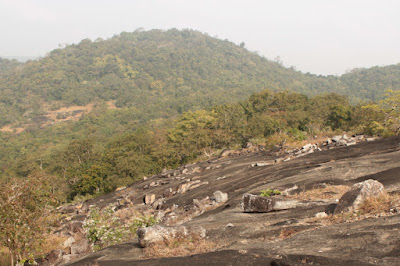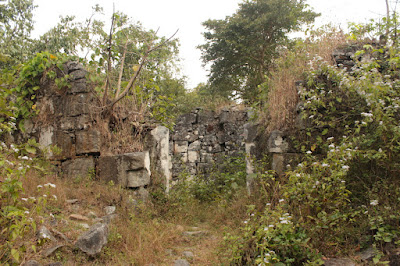Machigad is one of the small hill forts of Belgavi district. It is about 4 kilometers from Halasi. Machigad hill and Raamteerth hill are part of one group of hills. Machigad is the highest hill of the group. The hill seen in the below picture is Machigad, the fort ruins are concealed in the thick vegetation. This is the view of Machigad as seen from Raamteerth. As you see the hills are joined. In fact there's a direct route from Raamteerth to Machigad fort through the jungle. Only a local who has traveled in that path will be able to guide.
December 15, 2021
My day started with a trek to Raamteerth which is about 4.5 km from Halasi. By the time my trek ended and I returned to my car it was around 11-15. I had breakfast and contemplated the next destination- Machigad or BhuVaraha Devastana at Halasi. I decided to check out Machigad. I'll climb the hill if the trek was short and if a guide was found.
At Machigad, I happened to meet two gentlemen named Rajaram Shinde and Rajaram Hanabar. The latter appointed his son Kalmeshwar as my guide. This is Kalmeshwar leading me to Machigad fort. These steps were laid out recently so that people can ascend the hill comfortably. People here usually go up to the Mata Mandir inside the fort premises.
The steps ended in 5 minutes. From here steps have been made into the dirt, slabs will be laid out soon. I was trying to imagine the dirt path without steps... it could be slippery even during dry weather and perilous during rains.
The dirt steps too ended a few minutes later, then it was just dirt path but not too steep. At one point the village comes into view. The cement road is the approach to the fort, my car was parked at the end of road in the village.
As we climbed higher there were two or three hairpin bends in the path. Most of the way the path was flanked by walls of vegetation. Then suddenly the ruins were seen. The entire climb- from the village to the fort gate lasted 11 minutes. The walls are made of semi-finished granite blocks, probably sourced from this hill and also brought from Raamteerth side. Kalmeshwar waits while I take a few pictures. Only a hundred feet of wall is seen, the rest is lost into the vegetation.
Its a zigzag path into the fort. The walls, though made of rough cut blocks have a plain surface so that they are not scalable easily. The approximate age of these ruins could be 500 to 800 years. They have withstood the test of Nature. This hill can be very damp and wet during rainy season, yet the walls are almost intact.
Close to the fort entrance, on the left hand side is a shrine dedicated to Hanuman (see inset). Its a rule that every fort has a Hanuman shrine as a mark of strength and valor. Kalmesh removed his sandals at a distance, went to the shrine, removed dried flowers and did Namaskara to Hanuman. I guess all people of this village are quite religious here.
This is the second or the inner entrance. The distance between the two gateways could be 80 feet. I'm trying to imagine the massive wooden gates manning these passages. Probably the entrances had arches as well, which are not seen now.
The other side of the inner entrance. Seems like the inner walls are more damaged than the outer walls.
This is the second shrine of this fort. This little temple is dedicated to Mata Durga. Kalmeshwar went inside the temple, swept the floor clean, did Namaskara to Mata. He seemed so genuine with his emotions when it came to religious matters.
Next we head towards northern side passing over this rock. Kalmeshwar wanted me to see his village from here.
That's most of Machigad. The village is surrounded by paddy fields. Most people here speak Kannada and Marathi. We see lot of RCC houses now but if we go back 20 years we would've seen mostly tiled roof houses.
Kalmeshwar is doing PUC II in science. He has plans to do BCA. I felt it was a good choice. He said that he and friends spent their holidays on the hill.. this spot below is one of their favorites because of the view it offers. He said this spot was too good for photo shoots. Yes, he was right!
A bed of rock and an open view of the surroundings. It was a hazy day, clouds of mist shrouded the hills and plains. I liked the ambiance of this spot. However, we did not stop any place for long.
Raamteerth was visible from the spot. However, trees in the foreground blocked the view. Kalmeshwar said there's another spot which gives a clearer view of Raamteerth. We would be heading there next.
The photo shoot spot. Indeed its lovely.
The granite bed had lot of white bands on its surface. Must check out how these bands occur when the stone is formed.
Kalmeshwar led and I followed. He knew this fort like the back of his hand. The terrain was uneven, up & down, twists & turns, we had to bend to dodge thorny branches... it was a good exercise.
Then suddenly this marvelous little tank came into view. A hollow created by hacking out tons of stone. The tank must be 10' long, 7 ' wide and 6' deep which means its capacity is 11800 liters. Water was little greenish, that's because of the moss at the bottom. There was no odor as such. It seems this becomes a swimming pool for village boys during summers.
Rock-cut water tanks are wonderful creations. It may not be as easy as it seems. The stone workers need to know how deep the stone is. Wonder how they found out. And, I think this work was assigned to apprentices under close supervision. The other forts which have rock-cut tanks are Chitradurga fort and Chandragutti fort.
We has seen approximately half the fort. The tour will continue in the following post - Fort Machigad part-2.
.........































No comments:
Post a Comment